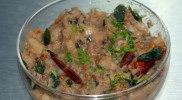This is a delicious chutney that you can quickly make to add to the main meal course as a...
Indian cranberry chutney is a sour chutney. Best had to cleanse your palette. Had with a ...

Brinjal & cucumber chutney or Vankaaya dosakaya pachadi is popularly made in Andhra cuisi...
This is a very simple chutney made with raw mango, bottle gourd peel. It is prepared in s...
Capsicum chutney is a very simple and nice variation to regular chutney varieties. Slow s...
An innovative and tangy dip made with pomegranate, spicy and tangy in taste. Pomegranate ...
Raw tamarind and coconut chutney is a sour taste and is frequently used in South India served with rice or dosa.
In Southern states of India such as Tamilnadu, Andhra Pradesh, Karnataka and Kerala, no breakfast is completed without having the coconut chutney which is a must complement for most of the South Indian dishes whether it is idli (steamed rice-lentil cakes), dosa (rice-lentil crepes) and even Ven Pongal/ Khara Pongal (rice-lentil risotto) or upma (semolina savory pudding).
Coconut chutney is one such natural and fres... Read More..
About Recipe
Chinthapandu pachadi, Puli karathuvaiyal, ?Tentool Tetul Chatni |
|||||||||||||||||||||||||||||||||||||
|
|||||||||||||||||||||||||||||||||||||
In Southern states of India such as Tamilnadu, Andhra Pradesh, Karnataka and Kerala, no breakfast is completed without having the coconut chutney which is a must complement for most of the South Indian dishes whether it is idli (steamed rice-lentil cakes), dosa (rice-lentil crepes) and even Ven Pongal/ Khara Pongal (rice-lentil risotto) or upma (semolina savory pudding).
Coconut chutney is one such natural and fresh raw food which taste incredibly fantastic when prepared with couple of right spices and ingredients. Coconut chutney made with fresh coconut, lentils, subtly spiced with green chilies and tempered with fresh curry leaves giving a calming pure essence and is the ideal complement for South Indian dishes.
It's a wonderful example of tradition, health, nutrition and raw cuisine. Chutney are often wet having a coarse to fine texture. In past times, chutneys were ground using a mortar and pestle made of stone or an ammikkal (Tamil). These days, electric blenders replace the stone implements. Several spices are added and ground, normally in a particular order; the wet paste is then tempered with seasoning in vegetable oil, gingerly or groundnut oil.
Variations of Coconut chutney:
There are lots of variations of chutney using coconut:
Spicy Coconut Chutney is hot and spicy and uses nominal ingredients. Chutney is not tempered and so the taste is different than the coconut chutney that is tempered. there is also a hint of cardamom in this chutney.
Red Coconut Chutney is mildly spiced and hot by using less red chilies. If you want a more reddish color in the chutney, then you can add Kashmiri red chilies. they aren't that much hot and there will be a good natural red coloring to the food.
Garlic Coconut Chutney made with the use of coconut, garlic, green chilies and then tempered with spices for more flavoring.
Coriander Coconut Chutney can also use for as spread while making kati rolls. add coriander to the process of coconut chutney and delicious chutney will get ready.
Apart of these varieties there are more variations such as pudina coconut chutney, tangy coconut chutney, Raw mango coconut chutney, coconut capsicum chutney, carrot coconut chutney, white coconut chutney etc.
Nutritional benefit of coconut chutney:
You will find 50 calories in 1 tablespoon of Coconut Chutney. In which 81% fat, 15% carb, 4% protein
 Easy recipes
Easy recipes
 Healthy Recipes
Healthy Recipes
 Dessert Recipes
Dessert Recipes
 Mutton and Lamb
Mutton and Lamb  Indian Bread Recipes
Indian Bread Recipes
 Dal Recipes
Dal Recipes
 Chutney and Pickles
Chutney and Pickles  Indo-Chinese Recipes
Indo-Chinese Recipes
 Snacks and Appetizers
Snacks and Appetizers
 Low Fat Recipes
Low Fat Recipes
 Chaat Recipes
Chaat Recipes
 Biryani and Rice
Biryani and Rice  Curry Recipes
Curry Recipes
 Indian Sweet Recipes
Indian Sweet Recipes
 Egg Recipes
Egg Recipes
 Paneer Recipes
Paneer Recipes
 Chicken Recipes
Chicken Recipes
 Indian tiffins
Indian tiffins
 Egg less Recipes
Egg less Recipes
 Soups and Salads
Soups and Salads
 Indian Sea Food
Indian Sea Food
 Manchurian Recipes
Manchurian Recipes
 Indian Drinks Recipes
Indian Drinks Recipes
 Dinner Recipes
Dinner Recipes